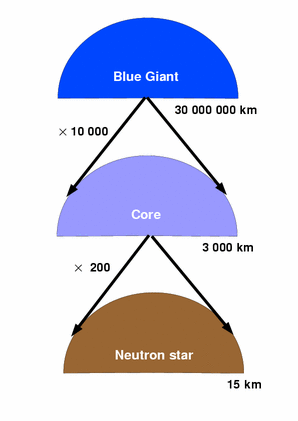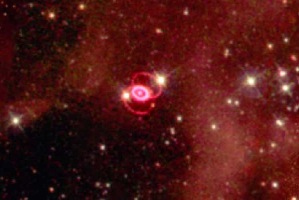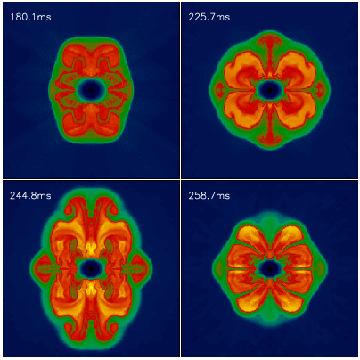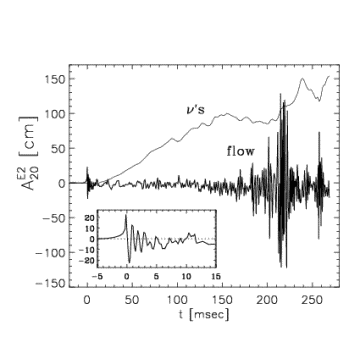|
|
 |
Supernovae are dramatic explosions of red or blue giant stars which
can be detected millions of light years away because for several weeks
they shine as bright as a whole galaxy consisting of hundreds of
billions of stars. This amazing optical outburst commences when the
explosion wave, generated in the optically obscured stellar center,
eventually reaches the surface layers of the star. As giant stars have
very large radii (30 to 500 million km) in spite of the large speed of
the explosion wave ( 10000km/sec), the spectacular optical
outburst begins only hours after the actual onset of the catastrophe,
which occurs in the very center of the star. There the burnt out
stellar core containing a mass comparable to that of our sun collapses
in a fraction of a second to a neutron star thereby liberating the
energy which causes the supernova explosion (Fig.1).
The only means to get direct and immediate information about the
supernova "engine" is from observations of neutrinos emitted by the
forming neutron star, and through gravitational waves which are
emitted when the collapse does not proceed perfectly
symmetrically. Contrary to electromagnetic waves, which are
oscillations of the electromagnetic field in spacetime, gravitational
waves are oscillations of the fabric of spacetime itself. According to
Albert Einstein, who first predicted their existence, gravitational
waves are produced whenever matter (or equivalently energy) is
accelerated aspherically. However, measurable signals are only
produced by astrophysical sources involving very strong gravitational
fields and velocities close to the speed of light, both of which are
encountered, for example, in aspherical supernovae, or during the
merger process of two neutron stars resulting in the formation of a
black hole.
The researchers at the Max-Planck-Institut für Astrophysik could
show that for a supernova exploding in our Galaxy or its neigbourhood,
the gravitational wave signal should be detectable by
 gravitational wave detectors
presently in operation or under construction
. Contrary to what was common wisdom before, they find that
the dominant contribution to the gravitational wave signal is not
necessarily produced when the collapse of a rotating stellar core is
stopped at neutron star densities (the so-called bounce signal), but
instead by violent turbulent mass motions (Fig.2) which take place
inside the forming neutron star and in its immediate neigbourhood
independent whether the star is rotating or not (Fig.3). Because the
mass motions stir up the whole center of the star the neutrinos
produced during the event are emitted asymmetrically, and hence also
cause a strong gravitational wave signal. According to the Max-Planck
researchers a measurement of the gravitational wave signal of a
galactic supernova together with a measurement of its neutrino signal
would provide important insights about the working of the "heart" of a
supernova. gravitational wave detectors
presently in operation or under construction
. Contrary to what was common wisdom before, they find that
the dominant contribution to the gravitational wave signal is not
necessarily produced when the collapse of a rotating stellar core is
stopped at neutron star densities (the so-called bounce signal), but
instead by violent turbulent mass motions (Fig.2) which take place
inside the forming neutron star and in its immediate neigbourhood
independent whether the star is rotating or not (Fig.3). Because the
mass motions stir up the whole center of the star the neutrinos
produced during the event are emitted asymmetrically, and hence also
cause a strong gravitational wave signal. According to the Max-Planck
researchers a measurement of the gravitational wave signal of a
galactic supernova together with a measurement of its neutrino signal
would provide important insights about the working of the "heart" of a
supernova.
Ewald Müller
Literature:
Müller, E., Rampp, M., Buras, R., Janka, H.-T. und Shoemaker, D.H.,
Astrophysical Journal 603 (2004) 221-230
|



